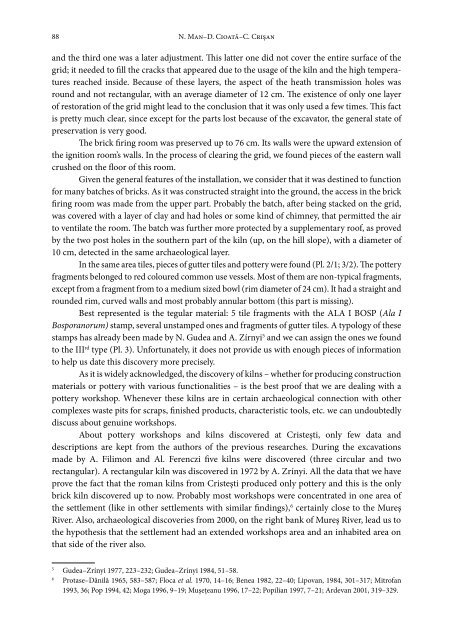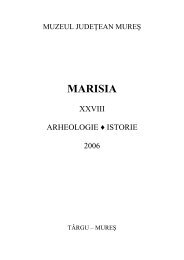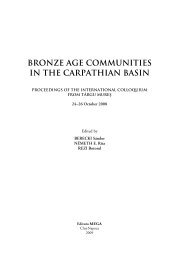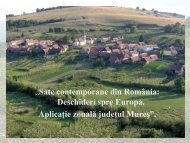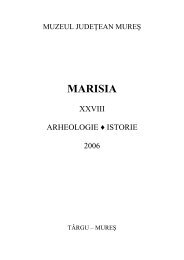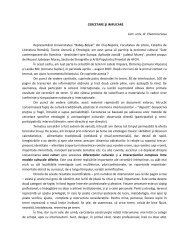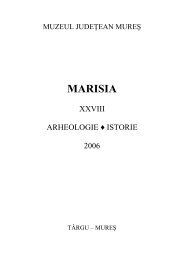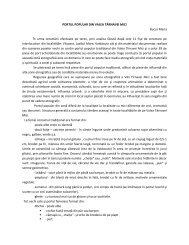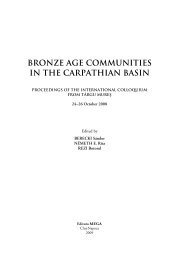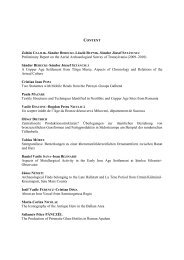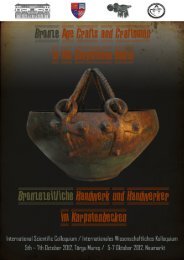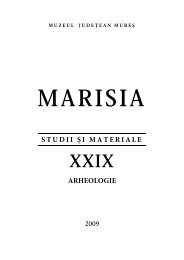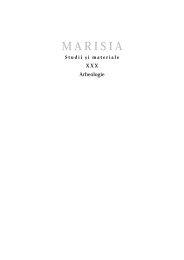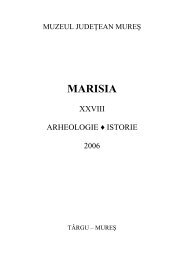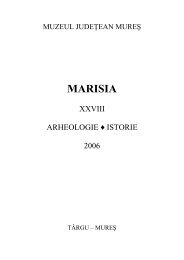A New Brick Kiln Discovered in the Roman Settlement from Cristești
A New Brick Kiln Discovered in the Roman Settlement from Cristești
A New Brick Kiln Discovered in the Roman Settlement from Cristești
Create successful ePaper yourself
Turn your PDF publications into a flip-book with our unique Google optimized e-Paper software.
88<br />
N. Man–D. Cioată–C. Crişan<br />
and <strong>the</strong> third one was a later adjustment. This latter one did not cover <strong>the</strong> entire surface of <strong>the</strong><br />
grid; it needed to fill <strong>the</strong> cracks that appeared due to <strong>the</strong> usage of <strong>the</strong> kiln and <strong>the</strong> high temperatures<br />
reached <strong>in</strong>side. Because of <strong>the</strong>se layers, <strong>the</strong> aspect of <strong>the</strong> heath transmission holes was<br />
round and not rectangular, with an average diameter of 12 cm. The existence of only one layer<br />
of restoration of <strong>the</strong> grid might lead to <strong>the</strong> conclusion that it was only used a few times. This fact<br />
is pretty much clear, s<strong>in</strong>ce except for <strong>the</strong> parts lost because of <strong>the</strong> excavator, <strong>the</strong> general state of<br />
preservation is very good.<br />
The brick fir<strong>in</strong>g room was preserved up to 76 cm. Its walls were <strong>the</strong> upward extension of<br />
<strong>the</strong> ignition room’s walls. In <strong>the</strong> process of clear<strong>in</strong>g <strong>the</strong> grid, we found pieces of <strong>the</strong> eastern wall<br />
crushed on <strong>the</strong> floor of this room.<br />
Given <strong>the</strong> general features of <strong>the</strong> <strong>in</strong>stallation, we consider that it was dest<strong>in</strong>ed to function<br />
for many batches of bricks. As it was constructed straight <strong>in</strong>to <strong>the</strong> ground, <strong>the</strong> access <strong>in</strong> <strong>the</strong> brick<br />
fir<strong>in</strong>g room was made <strong>from</strong> <strong>the</strong> upper part. Probably <strong>the</strong> batch, after be<strong>in</strong>g stacked on <strong>the</strong> grid,<br />
was covered with a layer of clay and had holes or some k<strong>in</strong>d of chimney, that permitted <strong>the</strong> air<br />
to ventilate <strong>the</strong> room. The batch was fur<strong>the</strong>r more protected by a supplementary roof, as proved<br />
by <strong>the</strong> two post holes <strong>in</strong> <strong>the</strong> sou<strong>the</strong>rn part of <strong>the</strong> kiln (up, on <strong>the</strong> hill slope), with a diameter of<br />
10 cm, detected <strong>in</strong> <strong>the</strong> same archaeological layer.<br />
In <strong>the</strong> same area tiles, pieces of gutter tiles and pottery were found (Pl. 2/1; 3/2). The pottery<br />
fragments belonged to red coloured common use vessels. Most of <strong>the</strong>m are non-typical fragments,<br />
except <strong>from</strong> a fragment <strong>from</strong> to a medium sized bowl (rim diameter of 24 cm). It had a straight and<br />
rounded rim, curved walls and most probably annular bottom (this part is miss<strong>in</strong>g).<br />
Best represented is <strong>the</strong> tegular material: 5 tile fragments with <strong>the</strong> ALA I BOSP (Ala I<br />
Bosporanorum) stamp, several unstamped ones and fragments of gutter tiles. A typology of <strong>the</strong>se<br />
stamps has already been made by N. Gudea and A. Zírnyi 5 and we can assign <strong>the</strong> ones we found<br />
to <strong>the</strong> III rd type (Pl. 3). Unfortunately, it does not provide us with enough pieces of <strong>in</strong>formation<br />
to help us date this discovery more precisely.<br />
As it is widely acknowledged, <strong>the</strong> discovery of kilns – whe<strong>the</strong>r for produc<strong>in</strong>g construction<br />
materials or pottery with various functionalities – is <strong>the</strong> best proof that we are deal<strong>in</strong>g with a<br />
pottery workshop. Whenever <strong>the</strong>se kilns are <strong>in</strong> certa<strong>in</strong> archaeological connection with o<strong>the</strong>r<br />
complexes waste pits for scraps, f<strong>in</strong>ished products, characteristic tools, etc. we can undoubtedly<br />
discuss about genu<strong>in</strong>e workshops.<br />
About pottery workshops and kilns discovered at Cristeşti, only few data and<br />
descriptions are kept <strong>from</strong> <strong>the</strong> authors of <strong>the</strong> previous researches. Dur<strong>in</strong>g <strong>the</strong> excavations<br />
made by A. Filimon and Al. Ferenczi five kilns were discovered (three circular and two<br />
rectangular). A rectangular kiln was discovered <strong>in</strong> 1972 by A. Zrínyi. All <strong>the</strong> data that we have<br />
prove <strong>the</strong> fact that <strong>the</strong> roman kilns <strong>from</strong> Cristeşti produced only pottery and this is <strong>the</strong> only<br />
brick kiln discovered up to now. Probably most workshops were concentrated <strong>in</strong> one area of<br />
<strong>the</strong> settlement (like <strong>in</strong> o<strong>the</strong>r settlements with similar f<strong>in</strong>d<strong>in</strong>gs), 6 certa<strong>in</strong>ly close to <strong>the</strong> Mureş<br />
River. Also, archaeological discoveries <strong>from</strong> 2000, on <strong>the</strong> right bank of Mureş River, lead us to<br />
<strong>the</strong> hypo<strong>the</strong>sis that <strong>the</strong> settlement had an extended workshops area and an <strong>in</strong>habited area on<br />
that side of <strong>the</strong> river also.<br />
5<br />
Gudea–Zrínyi 1977, 223–232; Gudea–Zrínyi 1984, 51–58.<br />
6<br />
Protase–Dănilă 1965, 583–587; Floca et al. 1970, 14–16; Benea 1982, 22–40; Lipovan, 1984, 301–317; Mitrofan<br />
1993, 36; Pop 1994, 42; Moga 1996, 9–19; Muşeţeanu 1996, 17–22; Popilian 1997, 7–21; Ardevan 2001, 319–329.


